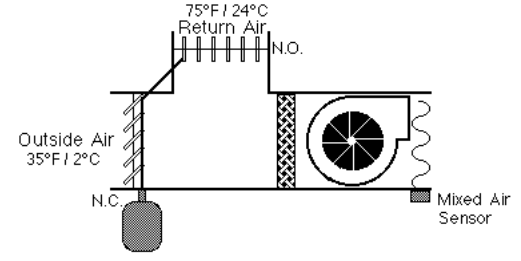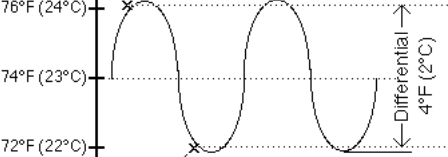| 1. |
The comfort zone for temperature is between 68°F (20°C) and 75°F (25°C). Temperatures less than 68°F (20°C) may cause some people to feel too _________. Temperatures greater than 78°F (25°C) may cause some people to feel too ________. |
|
|
hot;cold |
|
|
cold;hot |
| 2. |
What are essential to move the water in a system, whether it is from the boiler to the hot water coils, or from the chiller to the chilled water coils, or from the chiller to the cooling tower? |
|
|
Pump |
|
|
Steam Converter |
| 3. |
One way to control the temperature in a room is with a Wall Thermostat (stat) that sends a signal to an actuator that positions a damper to modulate the airflow in a variable air volume (VAV) box. These VAV boxes are installed in the space between the ceiling tile and the structural ceiling. |
|
|
True |
|
|
False |
| 4. |
Every control system, from the simplest room thermostat to the most complicated computerized control, has four basic elements. What are they and how are they synchronized? ( Refer to page- 18) |
|
|
Sensor -> Controller -> Controlled device -> Source of Energy |
|
|
Controlled device -> Source of Energy -> Sensor -> Controller |
| 5. |
The Control Point is the actual temperature being sensed. The Control Point (temperature) may not be on the setpoint, but instead may be above or below it. Systems operate to maintain the setpoint, plus or minus some acceptable limits called differential (two-position or on/off control) or throttling range (proportional control). |
|
|
True |
|
|
False |
| 6. |
_______ is the desired condition of a variable that is to be maintained, such as temperature. |
|
|
Setpoint |
|
|
Control point |
| 7. |
According to the diagram below, the mixed air sensor modulates the normally closed outside air dampers and the normally open return air dampers to maintain a temperature of 55°F (13°C). What action is needed for the controller? (Refer to Page-51)
 |
|
|
Direct Acting |
|
|
Reverse Acting |
| 8. |
Throttling range is sometimes referred to as sensitivity. Typical throttling ranges are _______ for mechanical controls such as mixed air control and the control of hot water supply. In contrast, room controls must be much tighter, with a throttling range between 2° and 4°F. |
|
|
10 and 18°F |
|
|
8 and 10°F |
| 9. |
Optimum Start can be a valuable strategy for saving energy if there are unoccupied times in a building. The optimum start program computes the best, or optimum, time to start the heating or cooling equipment so that at the precise beginning of occupied time, the zone is at the desired temperature. |
|
|
True |
|
|
False |
| 10. |
Which two energy management strategies are dependent upon the facility having Unoccupied Times? |
|
|
Timed Program Commands and Optimum Start |
|
|
Enthalpy Optimization and Night Purge Cycle |
| 11. |
Which of the following requires loads to be placed in a priority of importance, from non-essential loads to essential loads? |
|
|
Electric Demand Limiting |
|
|
Optimum Start |
| 12. |
A diagram of two-position control as it relates to time and temperature, appears below.

When the temperature reaches 76°F (24°C), the controller turns the DX cooling _____ causing the space to cool. (Refer to Page-63) |
|
|
OFF |
|
|
ON |
| 13. |
The ___________ is the change in the measured variable (i.e. temperature) required to cause the controlled device to go from ON to OFF. |
|
|
Differential |
|
|
Integral |
| 14. |
What equipment removes dirt particles from the mixed air; it is essential that these equipment be replaced periodically? |
|
|
Light Bulb |
|
|
Filters |
| 15. |
The comfort zone for humidity is between 20% relative humidity (RH) and 60% RH. Humidity less than 20% RH causes the room to be too dry, which has an adverse effect on health, computers, printers, and many other areas. Humidity greater than 60% RH causes the room to be muggy and increases the likelihood of mildew problems. |
|
|
True |
|
|
False |
|